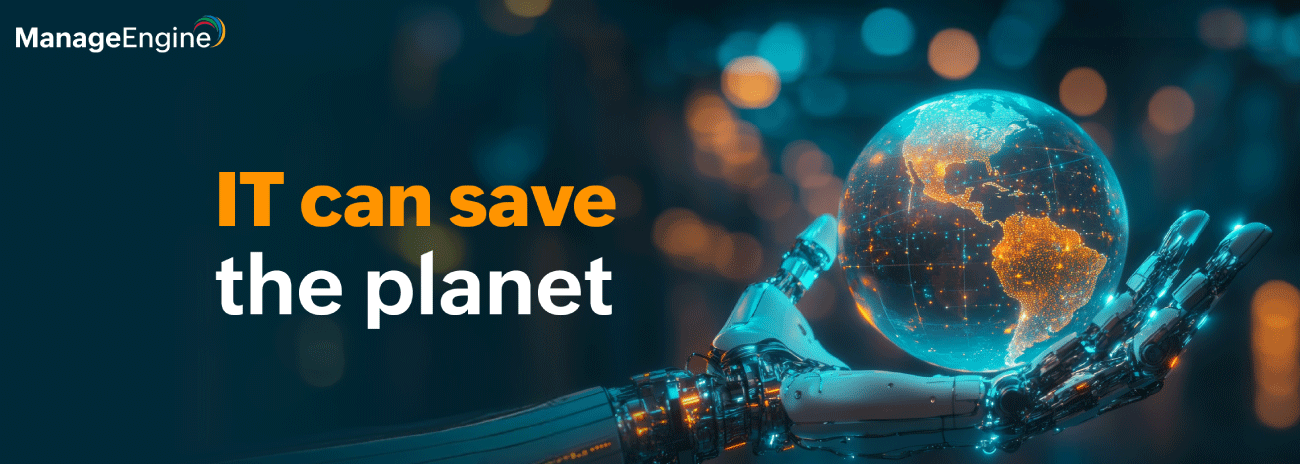IT can save the planet
 When we think about saving the planet, we usually imagine solar panels, electric cars, or governments making sweeping climate policies. Rarely do we picture rows of blinking servers in a data center or IT admins patching endpoints. Maybe we should. In today's world, the intersection between technology and sustainability is becoming impossible to ignore, and the IT industry is right at the center of it.
When we think about saving the planet, we usually imagine solar panels, electric cars, or governments making sweeping climate policies. Rarely do we picture rows of blinking servers in a data center or IT admins patching endpoints. Maybe we should. In today's world, the intersection between technology and sustainability is becoming impossible to ignore, and the IT industry is right at the center of it.
The truth is, IT is both part of the problem and part of the solution.
The digital world's carbon footprint
Let’s start with the uncomfortable reality. The tech that powers our daily lives runs on a vast, energy-hungry digital infrastructure. Data centers consume about 2% of the world’s electricity. Add that to the energy used by end-user devices, network hardware, and cooling systems, and the numbers climb even higher, and we’re not even talking about e-waste yet.
In other words, while technology is often seen as a clean industry, its carbon footprint is anything but invisible.
But here’s where things get interesting: The same industry that contributes to the problem is uniquely positioned to fix it.
IT as a sustainability enabler
Technology has always been about efficiency. Whether it’s automating repetitive tasks or optimizing entire workflows, IT has the power to reduce waste, both digital and physical. Now, more than ever, businesses are tapping into this potential not just to cut costs, but to meet their environmental goals.
Think about remote work. The sudden shift during the pandemic wouldn’t have been possible without robust IT systems in place. While remote work has its downsides, it has also significantly reduced daily commutes and the emissions that come with them.
That’s a real, measurable impact driven by IT.
Then there’s the cloud; moving from on-premise servers to cloud infrastructure doesn’t just improve scalability; it can also be greener. Major cloud providers are investing heavily in renewable energy and optimizing workloads to minimize energy waste. When done right, the cloud can help enterprises shrink their carbon footprint without compromising on performance.
Smarter systems, greener outcomes
The conversation around green tech often revolves around hardware, low-power devices, energy-efficient chips, and recyclable materials. However, we can't overlook the role of software in sustainability.
For instance, unified endpoint management tools now let organizations monitor and control the energy usage of thousands of devices. IT teams can automate power-saving settings, track idle time, and shut down systems after hours, all from a central dashboard. That’s not just smart; it’s sustainable.
At a larger scale, IT monitoring and analytics platforms can help businesses identify energy hogs across their network and optimize performance. With the right data, you can make better decisions not just about IT, but about your company’s environmental impact.
Beyond tools: The cultural shift
But going green isn't just about having the right tech stack. It’s also about mindset.
More companies are starting to recognize that sustainability needs to be baked into their IT strategy from day one, not tacked on as an afterthought. That means choosing vendors who are transparent about their energy sources, designing processes that reduce waste, and training employees to think consciously about how they use tech.
Even small things, like encouraging employees to clean out their inboxes (yes, storing old emails consumes energy) or shutting down unused VMs can add up. Sustainability, like security, has to be a shared responsibility.
So... can IT save the planet?
On its own? Probably not. But can it play a significant role? Absolutely.
IT isn’t just a behind-the-scenes enabler anymore. It’s a key driver of real-world impact. The choices we make about infrastructure, software, device management, and even policy can either contribute to the problem or help solve it.
The decisions we make today, no matter how small they seem, are shaping the future of our planet. That might sound dramatic, but it's true.
The good news? We have the tools. We have the knowledge. If we’re intentional about how we use them, we have a real shot at building a future where innovation and sustainability go hand in hand.